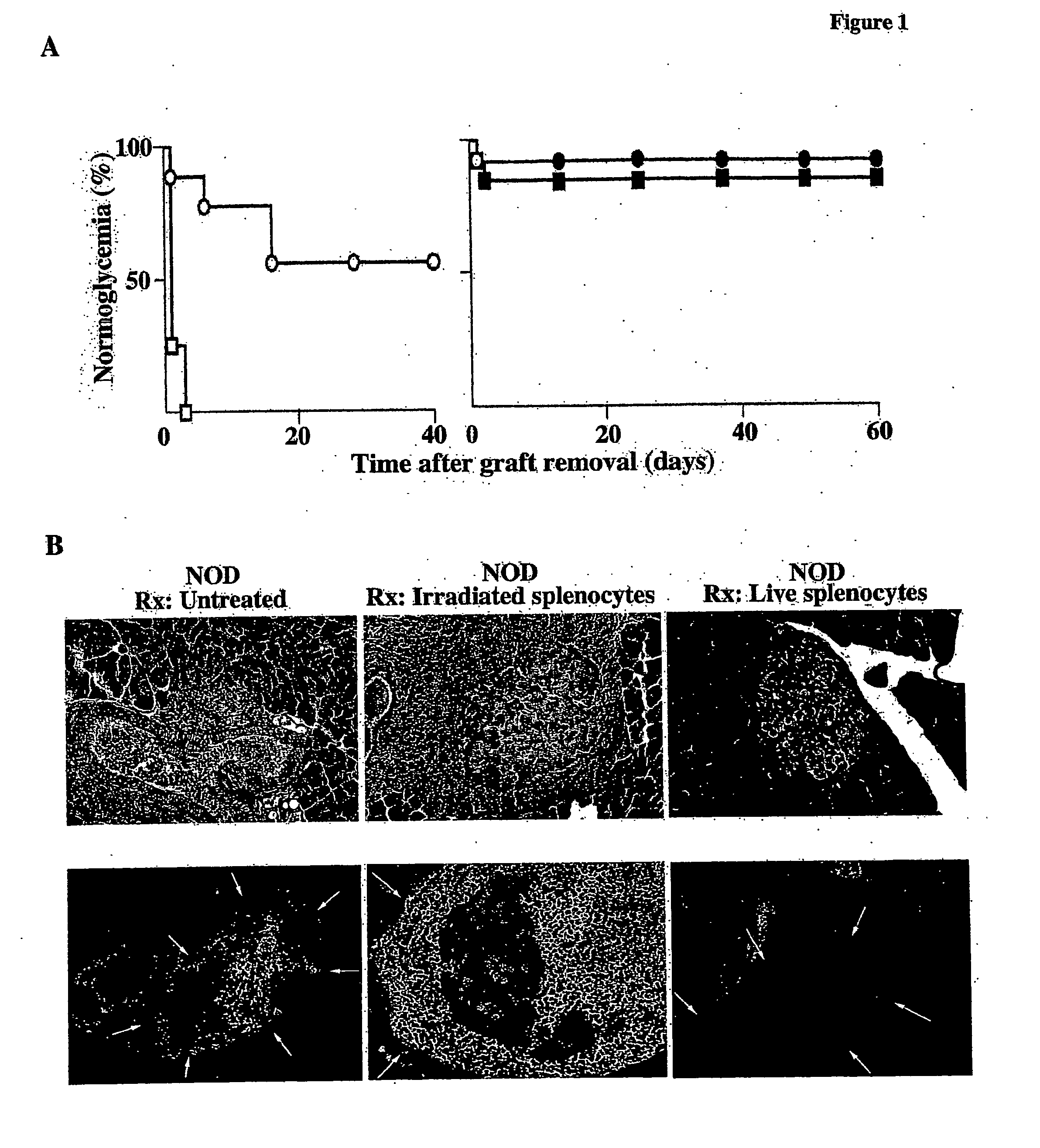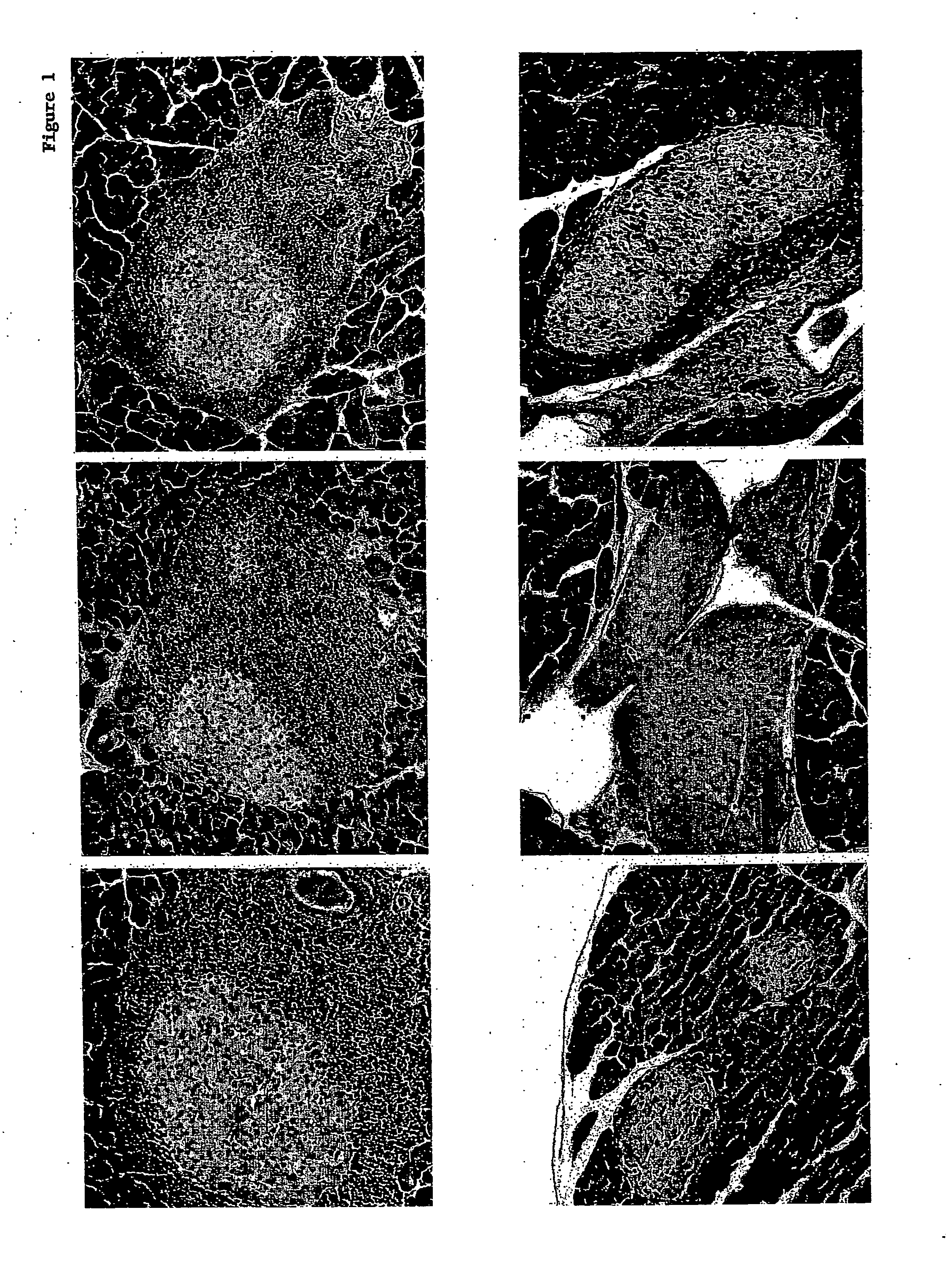Methods of organ regeneration
a technology of organ regeneration and organs, applied in the field of organ regeneration, can solve the problems of inability to apply clinically relevant approaches, inability to prevent end-stage diseases, and inability to permanently reverse insulitis,
- Summary
- Abstract
- Description
- Claims
- Application Information
AI Technical Summary
Problems solved by technology
Method used
Image
Examples
example 1
The Ability of Llive Versus Irradiated Donor Splenocytes to Modulate Autoimmunity
[0074] The ability of live versus irradiated donor splenocytes to modulate autoimmunity through selection of naïve T cells was examined as follows. Seventeen severely diabetic NOD females were randomized into two treatment groups that received CFA and either live or irradiated male CByB6F1 mouse splenocytes. This end-stage diabetic state was chosen to ensure both the lack of visible islets, either granulated or nongranulated, and the near-complete elimination of any remaining insulitis that might obscure dead or dying islets, as the pancreata of NOD mice with diabetes of recent onset may still contain scattered islets as well as remaining regions of insulitis (Table 1). Control of blood glucose concentration was achieved with a temporary implant of syngeneic islets under the capsule of one kidney. After the 40-day treatment regimen, the islet transplants were removed by unilateral nephrectomy and blood...
example 2
Kinetics of Pancreatic Islet Recovery
[0076] The kinetics of pancreatic islet recovery in additional groups of diabetic NOD mice was examined as follows. Twenty-five new and severely diabetic NOD females were randomized to treatment groups receiving CFA and either live or irradiated male splenocytes and temporary syngeneic islet transplants were maintained for 120 days before nephrectomy to allow a longer period for islet regeneration in situ. Eleven (92%) of the 12 NOD mice that received live splenocytes remained normoglycemic for greater than 26 weeks after disease onset or beyond 52 weeks of age. Moreover, 11 (85%) of the 13 NOD mice that received irradiated splenocytes also remained normoglycemic for greater than 27 weeks after disease onset or beyond 48 weeks of age (FIG. 1A). The longer period of ectopically imposed normoglycemia during treatment greatly increased the frequency of functional islet recovery in both experimental groups, with both live and irradiated splenocytes ...
example 3
Hematopoetic Chimerism
[0078] Lethal preconditioning (such as whole-body irradiation) of a host and introduction of MHC-matched bone marrow cells results in long-term hematopoetic chimerism (Weissman, Science 287: 1442, 2000). To determine whether hematopoetic chimerism also occured in the non-preconditioned NOD mouse hosts that received live or irradiated splenocytes according to the treatment protocol of Example 4, the peripheral blood lymphocytes (PBLS) of these animals was examined by flow cytometry at mean ages of 43 and 39 weeks, respectively, ˜17 weeks after diabetes onset and >11 weeks after the last injection of donor splenocytes (Table 2). Blood was obtained from the orbital vein, thereby allowing the mice to live after its collection.
[0079] The PBLs from NOD mice (H-2Kd) with disease reversal were examined for remaining live CByB6F1 donor cells (H-2KbKd) with allele-specific antibodies to the H-2Kb or H-2Kd MHC class I proteins. The results for five animals that received...
PUM
| Property | Measurement | Unit |
|---|---|---|
| concentrations | aaaaa | aaaaa |
| concentration | aaaaa | aaaaa |
| concentration | aaaaa | aaaaa |
Abstract
Description
Claims
Application Information
 Login to View More
Login to View More - R&D
- Intellectual Property
- Life Sciences
- Materials
- Tech Scout
- Unparalleled Data Quality
- Higher Quality Content
- 60% Fewer Hallucinations
Browse by: Latest US Patents, China's latest patents, Technical Efficacy Thesaurus, Application Domain, Technology Topic, Popular Technical Reports.
© 2025 PatSnap. All rights reserved.Legal|Privacy policy|Modern Slavery Act Transparency Statement|Sitemap|About US| Contact US: help@patsnap.com



